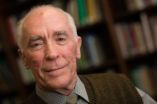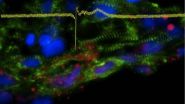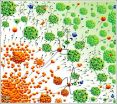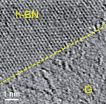(Press-News.org) Tel Aviv — Because half of all instances of hearing loss are linked to genetic mutations, advanced gene research is an invaluable tool for uncovering causes of deafness — and one of the biggest hopes for the development of new therapies. Now Prof. Karen Avraham of the Sackler Faculty of Medicine at Tel Aviv University has discovered a significant mutation in a LINC family protein — part of the cells of the inner ear — that could lead to new treatments for hearing disorders.
Her team of researchers, including Dr. Henning Horn and Profs. Colin Stewart and Brian Burke of the Institute of Medical Biology at A*STAR in Singapore, discovered that the mutation causes chaos in a cell's anatomy. The cell nucleus, which contains our entire DNA, moves to the top of the cell rather than being anchored to the bottom, its normal place. Though this has little impact on the functioning of most of the body's cells, it's devastating for the cells responsible for hearing, explains Prof. Avraham. "The position of the nucleus is important for receiving the electrical signals that determine proper hearing," she explains. "Without the ability to receive these signals correctly, the entire cascade of hearing fails."
This discovery, recently reported in the Journal of Clinical Investigation, may be a starting point for the development of new therapies. In the meantime, the research could lead towards work on a drug that is able to mimic the mutated protein's anchoring function, and restore hearing in some cases, she suggests.
From human to lab to mouse
Prof. Avraham originally uncovered the genetic mutation while attempting to explain the cause of deafness in two families of Iraqi Jewish descent. For generations, members of these families had been suffering from hearing loss, but the medical cause remained a mystery. Using deep genetic sequencing, a technology used to sequence the entire human genome, she discovered that the hearing impaired members of both families had a mutated version of the protein Nesprin4, a part of the LINC group of proteins that links the cell's nucleus to the inner wall of the cell.
In the lab, Prof. Avraham recreated this phenomenon by engineering the mutation in single cells. With the mutation in place, Nesprin4 was not found in the area around the cell nucleus, as in healthy cells, but was spread throughout the entire cell. Investigating further, she studied lab mice that were engineered to be completely devoid of the protein.
Created in Singapore, the mice were originally engineered to study the biology of LINC proteins. The fact that they were deaf came as a complete surprise to researchers. Without this protein serving as an anchor, the cell nucleus is not located in the correct position within inner ear cells, but seems to float throughout. This causes the cells' other components to reorient as well, ultimately harming the polarity of the cells and hindering electrical signals. It's a mutation that took a heavy toll on the cells' ability to transfer sound signals, explains Prof. Avraham, rendering the mice deaf.
Given the similarity between mouse and human inner ear cells, researchers predict that the same phenomenon is occurring in human patients with a mutation in the Nesprin4 gene.
Looking for a wider impact
Prof. Avraham says that she and her collaborators are the first to reveal this mutation as a cause of deafness. "Now that we have reported it, scientists around the world can test for mutations in this gene," she notes. The mutation could indeed be a more common genetic cause of deafness in a number of populations. And because Nesprin4 belongs to a family of proteins that have been linked to other diseases, such as muscular coordination and degeneration disorders, this could prove a ripe area for further research.
At TAU, the research was supported by the National Institutes of Health – NIDCD and Israeli Center of Research Excellence, I-CORE.
INFORMATION:
American Friends of Tel Aviv University (www.aftau.org) supports Israel's leading, most comprehensive and most sought-after center of higher learning. Independently ranked 94th among the world's top universities for the impact of its research, TAU's innovations and discoveries are cited more often by the global scientific community than all but 10 other universities.
Internationally recognized for the scope and groundbreaking nature of its research and scholarship, Tel Aviv University consistently produces work with profound implications for the future.
Discovering the missing 'LINC' to deafness
Mutation in a genetic protein prevents hearing, reports a Tel Aviv University researcher
2013-01-28
ELSE PRESS RELEASES FROM THIS DATE:
With hot air treatment, bacteria fly the coop
2013-01-28
This press release is available in Spanish.Poultry producers can reduce bacterial cross-contamination in poultry cages by treating the cages with forced air that's been heated to 122 degrees Fahrenheit, according to a study by U.S. Department of Agriculture (USDA) scientists.
While being transported in coops on trucks, poultry that have bacteria such as Campylobacter can contaminate, through their feces, other poultry that are free of pathogens. Those disease-causing bacteria can then be passed on to the next group of birds during the next trip, and so forth, unless ...
Islet transplant may slow progression of atherosclerosis
2013-01-28
Minimally invasive islet transplantation for patients with type 1 diabetes achieves insulin independence and reverses the progression of atherosclerosis in the first few years after transplant, according to a University of Illinois at Chicago study.
The research is published in the February issue of the journal Diabetes Care and is available online.
Patients with diabetes, particularly women, have a substantial increased risk of dying from ischemic heart disease, according to previous research. However, future cardiac events may be prevented with intensive glycemic ...
Central Valley irrigation intensifies rainfall, storms across the Southwest
2013-01-28
Irvine, Calif., Jan. 28, 2013 – Agricultural irrigation in California's Central Valley doubles the amount of water vapor pumped into the atmosphere, ratcheting up rainfall and powerful monsoons across the interior Southwest, according to a new study by UC Irvine scientists.
Moisture on the vast farm fields evaporates, is blown over the Sierra Nevada and dumps 15 percent more than average summer rain in numerous other states. Runoff to the Colorado River increases by 28 percent, and the Four Corners region experiences a 56 percent boost in runoff. While the additional ...
Safeguards needed for tissue donors
2013-01-28
Donors to biobanks – vast collections of human tissue samples that scientists hope will lead to new treatments for diseases – have a right to basic information about how their donations may be used, a Michigan State University ethicist argues in a new paper.
The idea behind biobanks is that a repository with hundreds of thousands of samples, each linked to medical records and other health information, can yield discoveries smaller data sets can't match. Once samples are collected, researchers in many fields can use the data repeatedly.
"More and larger biobanks are ...
New LGBT Health journal launching in 2013
2013-01-28
New Rochelle, NY, January 28, 2013—Over 4 million adults in the United States identify as gay, lesbian, or bisexual and approximately 700,000 identify as transgender. An NIH-sponsored investigation by the Institute of Medicine (IOM) concluded that the health status and healthcare needs of this sizable population are poorly understood and likely inadequately met. A journal is urgently needed to support, promote, and address the unique healthcare needs of each population that comprises the LGBT community, in the United States and worldwide. LGBT Health, a new peer-reviewed ...
Best friends influence when teenagers have first drink
2013-01-28
Chances are the only thing you remember about your first swig of alcohol is how bad the stuff tasted. What you didn't know is the person who gave you that first drink and when you had it says a lot about your predisposition to imbibe later in life.
A national study by a University of Iowa-led team has found that adolescents who get their first drink from a friend are more likely to drink sooner in life, which past studies show makes them more prone to abusing alcohol when they get older. The finding is designed to help specialists predict when adolescents are likely to ...
Patients' own skin cells are transformed into heart cells to create 'disease in a dish'
2013-01-28
LA JOLLA, Calif., January 27, 2013 – Most patients with an inherited heart condition known as arrhythmogenic right ventricular dysplasia/cardiomyopathy (ARVD/C) don't know they have a problem until they're in their early 20s. The lack of symptoms at younger ages makes it very difficult for researchers to study how ARVD/C evolves or to develop treatments. A new stem cell-based technology created by 2012 Nobel Prize winner Shinya Yamanaka, M.D., Ph.D., helps solve this problem. With this technology, researchers can generate heart muscle cells from a patient's own skin cells. ...
Demagnetization by rapid spin transport
2013-01-28
For purposes of their research, the scientists irradiated two separate layered systems with ultrashort laser pulses on the order of just one hundred femtoseconds (10-15 s). One sample consisted essentially of a single thin layer of ferromagnetic nickel. By contrast, a second sample of this same nickel material was coated with a non-magnetic layer of gold. Only a mere 30 nanometers (10-9 m) thick, the gold layer swallowed up the lion's share of the laser light so that barely any light ended up reaching the nickel layer. In spite of this, the nickel layer's magnetization ...
Accelerating neutral atoms on a table top
2013-01-28
Charged particle accelerators have become crucially important to modern day life, be it in health care for cancer treatment or for answering important fundamental scientific questions like the existence of the HIGGS boson, the so called 'God particle'. In a simple picture, charged particles like electrons and protons are accelerated between two end plates across which an electrical voltage is applied. High energies need high voltages (millions and billions of volts) and long acceleration paths in giant sized machines – for instance the trillion volt machine called the 'large ...
Rice technique points toward 2-D devices
2013-01-28
HOUSTON – (Jan. 28, 2013) – Rice University scientists have taken an important step toward the creation of two-dimensional electronics with a process to make patterns in atom-thick layers that combine a conductor and an insulator.
The materials at play – graphene and hexagonal boron nitride – have been merged into sheets and built into a variety of patterns at nanoscale dimensions.
Rice introduced a technique to stitch the identically structured materials together nearly three years ago. Since then, the idea has received a lot of attention from researchers interested ...
LAST 30 PRESS RELEASES:
Numbers in our sights affect how we perceive space
SIMJ announces global collaborative book project in commemoration of its 75th anniversary
Air pollution exposure and birth weight
Obstructive sleep apnea risk and mental health conditions among older adults
How talking slows eye movements behind the wheel
The Ceramic Society of Japan’s Oxoate Ceramics Research Association launches new international book project
Heart-brain connection: international study reveals the role of the vagus nerve in keeping the heart young
Researchers identify Rb1 as a predictive biomarker for a new therapeutic strategy in some breast cancers
Survey reveals ethical gaps slowing AI adoption in pediatric surgery
Stimulant ADHD medications work differently than thought
AI overestimates how smart people are, according to HSE economists
HSE researchers create genome-wide map of quadruplexes
Scientists boost cell "powerhouses" to burn more calories
Automatic label checking: The missing step in making reliable medical AI
Low daily alcohol intake linked to 50% heightened mouth cancer risk in India
American Meteorological Society announces Rick Spinrad as 2026 President-Elect
Biomass-based carbon capture spotlighted in newly released global climate webinar recording
Illuminating invisible nano pollutants: advanced bioimaging tracks the full journey of emerging nanoscale contaminants in living systems
How does age affect recovery from spinal cord injury?
Novel AI tool offers prognosis for patients with head and neck cancer
Fathers’ microplastic exposure tied to their children’s metabolic problems
Research validates laboratory model for studying high-grade serous ovarian cancer
SIR 2026 delivers transformative breakthroughs in minimally invasive medicine to improve patient care
Stem Cell Reports most downloaded papers of 2025 highlight the breadth and impact of stem cell research
Oxford-led study estimates NHS spends around 3% of its primary and secondary care budget on the health impacts of heat and cold in England
A researcher’s long quest leads to a smart composite breakthrough
Urban wild bees act as “microbial sensors” of city health.
New study finds where you live affects recovery after a hip fracture
Forecasting the impact of fully automated vehicle adoption on US road traffic injuries
Alcohol-related hospitalizations from 2016 to 2022
[Press-News.org] Discovering the missing 'LINC' to deafnessMutation in a genetic protein prevents hearing, reports a Tel Aviv University researcher




